Between februari 23 and march 1st, Malin and I spent a week in Athens, Greece. We enjoyed the wonderful weather, the great people we have met, the delicious greek food, a lot of old and new culture, modern and classic arts and some advanced modern architecture. Here a some of the highlights that we have enjoyed in Athens.
Remember, you’ll find more photos here and under < travels >.
Places to visit:
Acropolis of Athens
odysseus.culture.gr




One of the things you can not miss when visiting Athens! We bought an ‘all-inclusive-ticket’ for € 20 which was valid for the entire archaeological site of the Acropolis and its slopes during 5 days. Which gives you enough time to visit most of the following sites: Acropolis of Athens, Ancient Agora of Athens, Archaeological Museum of Kerameikos, Archaeological Site of Lykeion, Hadrian’s Library, Kerameikos, Museum of the Ancient Agora, North slope of Acropolis, Olympieio, Roman Agora of Athens and the South Slope of Acropolis.
“The Acropolis of Athens is an ancient citadel located on an extremely rocky outcrop above the city of Athens and contains the remains of several ancient buildings of great architectural and historic significance, the most famous being the Parthenon. The word acropolis comes from the Greek words ἄκρον (akron, “highest point, extremity”) and πόλις (polis, “city”). Although there are many other acropoleis in Greece, the significance of the Acropolis of Athens is such that it is commonly known as “The Acropolis” without qualification.
While there is evidence that the hill was inhabited as far back as the fourth millennium BC, it was Pericles (c. 495 – 429 BC) in the fifth century BC who coordinated the construction of the site’s most important buildings including the Parthenon, the Propylaia, the Erechtheion and the Temple of Athena Nike. The Parthenon and the other buildings were seriously damaged during the 1687 siege by the Venetians in the Morean War when gunpowder being stored in the Parthenon was hit by a cannonball and exploded.”
The Acropolis Museum
15 Dionysiou Areopagitou Street, Athens
www.theacropolismuseum.gr



The all new Acropolis Museum is a new and wonderful archaeological museum focused on the findings of the archaeological sites of the Acropolis of Athens. The museum was built to house every artifact found on the rock and on the surrounding slopes, from the Greek Bronze Age to Roman and Byzantine Greece. It also lies over the ruins of a part of Roman and early Byzantine Athens.
“The museum was founded in 2003, while the Organization of the Museum was established in 2008. It opened to the public on 20 June 2009. Nearly 4,000 objects are exhibited over an area of 14,000 square meters. Architect of the New Acropolis Museum was Bernard Tschumi Architects from New York/Paris.
With exhibition space of more than 14,000 square meters and a full range of modern visitor amenities, the New Acropolis Museum tells the complete story of life on the Athenian Acropolis and its surroundings. It does so by uniting collections that were dispersed in multiple institutions. The rich collections will provide visitors with a comprehensive picture of the human presence on the Acropolis, from pre-historic times through late Antiquity. Integral to this program is the display of an archaeological excavation on the site of the Museum itself: ruins from the 4th through 7th centuries A.D., left intact and protected beneath the building and made visible through the first floor.”
Archaelogical site of Keramikos
Ermou 125 in Athina
odysseus.culture.gr
www.athensinfoguide.com


Close to our apartment, and on our walking path to the centre lies Keramikos. Worthwile to mention that here you’ll find a interesting museum with some very nice statues and outisde the ruins of the temples are visible. We saw a lot of turtle keeping the grass short there. Can you spot them?
“Keramikos is located to the northwest of the Acropolis, which includes an extensive area both within and outside the ancient city walls, on both sides of the Dipylon (Δίπυλον) Gate and by the banks of the Eridanos River. It was the potters’ quarter of the city, from which the English word “ceramic” is derived, and was also the site of an important cemetery and numerous funerary sculptures erected along the road out of the city towards Eleusis. The Kerameikos Archaeological Museum is located in Kerameikos, Athens, Greece and was built in 1937. It houses many important early Geometric Art pieces that date as far back as 860 BC. It was expanded in the 1960s by the Boehringer brothers of Boehringer Ingelheim fame.”
Ancient Agora
Adrianou in Athina
odysseus.culture.gr
Als on the slopes of the Acropolis, the Ancient Agora offers some very nice classic Greek spots!
“The Ancient Agora of Classical Athens is the best-known example of an ancient Greek agora, located to the northwest of the Acropolis and bounded on the south by the hill of the Areopagus and on the west by the hill known as the Agoraios Kolonos, also called Market Hill. After the initial phase of excavation, in the 1950s, the Hellenistic Stoa of Attalos was reconstructed on the east side of the agora, and today it serves as a museum and as storage and office space for the excavation team. The museum is housed in the Stoa of Attalos, and its exhibits are connected with the Athenian democracy. The collection of the museum includes clay, bronze and glass objects, sculptures, coins and inscriptions from the 7th to the 5th century BC, as well as pottery of the Byzantine period and the Turkish occupation.”
Stoa of Attalos
“The Stoa, on the east side of the Ancient Agora, was the gift of Attalos II, King of Pergamon, as a fragmentary inscription on the epistyle of its lower colonnade shows:
«King Attalos, son of Attalos and of Queen Apollonis».”

“The building is 120 m wide and 20 m deep and had two floors with a second series of columns on the interior and 21 shops at the back of both floors. On the ground floor the exterior colonnade was Doric and the interior Ionic, without fluting. On the upper floor the exterior colonnade was Ionic, and the interior had capitals of a Pergamene type. The Stoa of Attalos was a place for Athenians to meet, walk, and to do business. It was destroyed by the Heruli in A.D. 267, and its members were incorporated into the Late Roman Wall. The restoration, based on studies by the architect Yannis Travlos, was carried out in 1953-1956 by the American School of Classical Studies, with the financial support of John D. Rockefeller, Jr.”
Temple of Hephaistos
“On top of Agoraios Kolonos hill, which is delimiting the Ancient Agora of Athens to the west, stands the temple of Hephaestus, broadly known as Thisio.”

“It is one of the best preserved ancient temples, partly because it was transformed into a Christian church. According to the traveller and geographer Pausanias, two deities were jointly worshipped in the temple: god Hephaestus, protector of all metallurgists, and goddess Athena Ergani, protecting all potters and the cottage industries. The identification of this temple as Hephaesteion (location of worship of the god Hephaestus) was ascertained by the excavations and investigations that brought to light metallurgy workshops on the wider area of the hill, thus outshining earlier opinions presuming that Theseus, Hercules or Aris (Mars) were the deities worshipped there. The temple was probably erected between 460 and 420 BC by a yet unknown architect, to whom, however, are attributed other temples of similar structure in the Attica region.”
Theatre of Dionysus
Mitseon 25 in Athens
www.visit-ancient-greece.com

The Theatre of Dionysus Eleuthereus is a major theatre in Athens, built at the foot of the Athenian Acropolis. Dedicated to Dionysus, the god of plays and wine (among other things), the theatre could seat as many as 17,000 people with excellent acoustics, making it an ideal location for ancient Athens’ biggest theatrical celebration, the Dionysia. It was the first stone theatre ever built, cut into the southern cliff face of the Acropolis, and supposedly birthplace of Greek tragedy. The remains of a restored and redesigned Roman version can still be seen at the site today. It is sometimes confused with the later, smaller, and better-preserved Odeon of Herodes Atticus, located nearby on the southwest slope of the Acropolis.
The site was used as a theatre since the sixth century BC. The existing structure dates back to the fourth century BC but had many other later remodellings. On November 24, 2009 the Greek government announced that they would partially restore the Theatre of Dionysus.
Odeon of Herodes Atticus
Areopagitou Dionisiou in Athens
odysseus.culture.gr

The Odeon of Herodes Atticus is a stone theatre structure located on the southwest slope of the Acropolis of Athens. It was built in 161 AD by the Athenian magnate Herodes Atticus in memory of his wife, Aspasia Annia Regilla. It was originally a steep-sloped theater with a three-story stone front wall and a wooden roof made of expensive, cedar of Lebanon timber. It was used as a venue for music concerts with a capacity of 5,000. It lasted intact until it was destroyed and left in ruins by the Heruli in 267 AD. The audience stands and the orchestra (stage) were restored using pentelic marble in the 1950s. Since then it has been the main venue of the Athens Festival, which runs from May through October each year, featuring a variety of acclaimed Greek as well as International performances.
Greek Parliament with the Presidential Guard
Syndagma Square in Athens
www.hellenicparliament.gr or en.wikipedia.org Hellenic_Parliament and www.proedriki-froura.gr or en.wikipedia.org Evzones

The Hellenic Parliament is the parliament of Greece, located in the Old Royal Palace, overlooking Syntagma Square in Athens. The Parliament is the supreme democratic institution that represents the citizens through an elected body of Members of Parliament.
It is a unicameral legislature of 300 members, elected for a four-year term. During 1844–63 and 1927–35 the parliament was bicameral with an upper house, the Senate, and a lower house, the Chamber of Deputies, which retained the name Vouli. Several important Greek statesmen have served as Speakers of the Hellenic Parliament.

The the Presidential Guard or Evzones is the name of several historical elite light infantry and mountain units of the Greek Army. Today, it refers to the members of the Presidential Guard, an elite ceremonial unit that guards the Greek Tomb of the Unknown Soldier, the Presidential Mansion and the gate of Evzones camp in Athens.
Though the Presidential Guard is a primarily ceremonial unit, all Evzones are volunteers drawn from the Hellenic Army’s Infantry Corps. Prospective Evzones are initially identified at the Infantry Recruit Training Centres during Basic Training; there is a minimum height requirement of 1.87 m to join.
The unit is known for its uniform, which has evolved from the clothes worn by the klephts who fought the Ottoman occupation of Greece. The most visible item of this uniform is the fustanella, a kilt-like garment. Their distinctive dress turned them into a popular image for the Greek soldier, especially among foreigners.
Botanical Museum of the National Gardens
Leof. Vasilissis Sofias in Athina
www.greece-athens.com

The National Garden (formerly the Royal Garden) is a public park of 15.5 hectares in the center of the Greek capital, Athens. It is located directly behind the Greek Parliament building (The Old Palace) and continues to the South to the area where the Zappeion is located, across from the Panathenaiko or Kalimarmaro Olympic Stadium of the 1896 Olympic Games. The Garden also encloses some ancient ruins, tambourines and Corinthian capitals of columns, mosaics, and other features. On the Southeast side are the busts of Ioannis Kapodistrias, the first governor of Greece, and of the Philhellene Jean-Gabriel Eynard. On the South side are the busts of the celebrated Greek poets Dionysios Solomos, author of the Greek National Hymn, and Aristotelis Valaoritis.
Panathenaic Stadium
Vasileos Konstantinou Anevue (opposite the statue of Myron Discobolus) in Athens
www.panathenaicstadium.gr

The Panathenaic Stadium is a classical cultural and touristic monument of Greece and one of the most significant monuments not only for Athens, but for the whole Greece.
It is one of our city’s most popular touristic attractions and one of Athens’ landmarks. Its rich history is directly connected to the Modern Olympic Games as from their revival in 1896 until the Athens Olympic Games in 2004. It is also the place from where the Olympic flame sets up its journey to the cities of the Olympic Games, both Winter, Summer and Youth.
Temple of Olympian Zeus
Vassilisis Olgas Av. in Athens
odysseus.culture.gr

The Temple of Olympian Zeus is a monument of Greece and a former colossal temple at the centre of the Greek capital Athens. It was dedicated to Olympian Zeus, a name originating from his position as head of the Olympian gods. Construction began in the 6th century BC during the rule of the Athenian tyrants, who envisaged building the greatest temple in the ancient world, but it was not completed until the reign of the Roman Emperor Hadrian in the 2nd century AD, some 638 years after the project had begun. During the Roman period the temple -that included 104 colossal columns- was renowned as the largest temple in Greece and housed one of the largest cult statues in the ancient world.
The temple’s glory was short-lived, as it fell into disuse after being pillaged during a barbarian invasion in the 3rd century AD, just about a century after its completion. It was probably never repaired and was reduced to ruins thereafter. In the centuries after the fall of the Roman Empire, it was extensively quarried for building materials to supply building projects elsewhere in the city. Despite this, a substantial part of the temple remains today, notably sixteen of the original gigantic columns, and it continues to be part of a very important archaeological site of Greece.
Arch of Hadrian
Leoforos Vasilisis Amalias, Athina
en.wikipedia.org

The Arch of Hadrian, most commonly known in Greek as Hadrian’s Gate, is a monumental gateway resembling – in some respects – a Roman triumphal arch. It spanned an ancient road from the center of Athens, Greece, to the complex of structures on the eastern side of the city that included the Temple of Olympian Zeus. It has been proposed that the arch was built to celebrate the adventus (arrival) of the Roman Emperor Hadrian and to honor him for his many benefactions to the city, on the occasion of the dedication of the nearby temple complex in 131 or 132 AD. It is not certain who commissioned the arch, although it is probable that the citizens of Athens or another Greek group were responsible for its construction and design. There were two inscriptions on the arch, facing in opposite directions, naming both Theseus and Hadrian as founders of Athens. While it is clear that the inscriptions honor Hadrian, it is uncertain whether they refer to the city as a whole or to the city in two parts: one old and one new. The early idea, however, that the arch marked the line of the ancient city wall, and thus the division between the old and the new regions of the city, has been shown to be false by further excavation. The arch is located 325 m southeast of the Acropolis.
Benaki Museum
Koumpari 1 in Athens
www.benaki.gr


The Benaki Museum occupies one of the few neoclassical buildings that continue to resist the aesthetic deterioration of postwar Athens. It is located on an exceptionally favourable location in the historic centre of the city, right opposite the lush greenery of the National Gardens and the garden of the Presidential Mansion, and in the same vicinity as related institutions such as the Museum of Cycladic Art and the Byzantine and Christian Museum. The Benaki Museum building is a complex architectural group with a fairly eventful history.
Benaki Museum
138 Pireos Street in Athens
www.benaki.gr
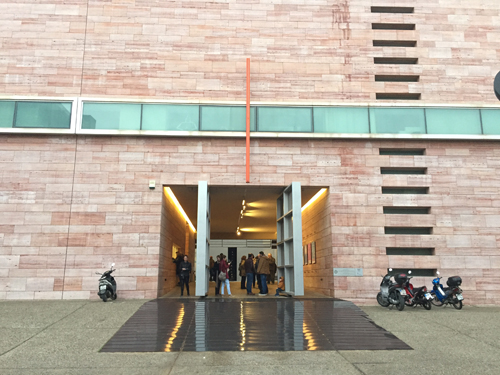
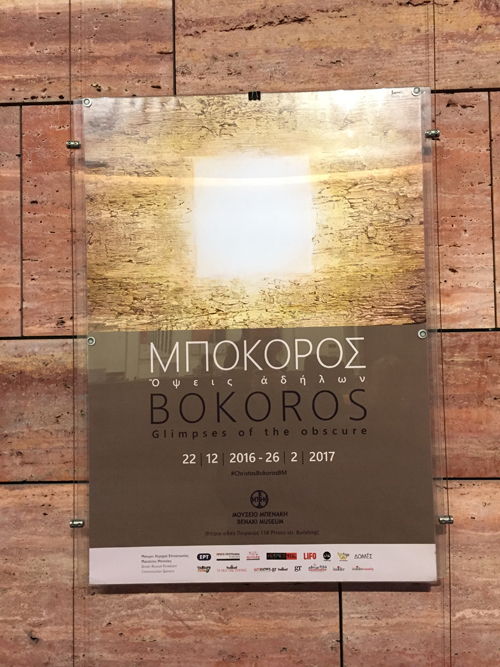
It would be criminal to come to Athens and miss the Acropolis but visitors who stick only to the city’s ancient past are missing out. Part of the excellent Benaki art and design museum, which sprawls across seven sites, the Pireos Street gallery is a forbidding pink cube in the warehouse district of Gazi that hosts some of Athens’ best contemporary art exhibitions. It is particularly popular on weekend evenings, when it closes at 10pm.
Stavros Niarchos Foundation Cultural Center
364 Syggrou Avenue in Kallithea (near Pireaus) in Athens
www.snfcc.org



The Stavros Niarchos Foundation Cultural Center is a complex in the bay of Phaliron in Athens which includes new facilities for the National Library of Greece and the National Opera. The Center was designed by architect Renzo Piano and is being built by the Stavros Niarchos Foundation. The €566 million project was completed in 2016, and will be donated to the Greek state in 2017.
Renzo Piano envisaged the SNFCC rising out of the ground like a dislodged piece of the earth’s crust. As a result, an artificial hill is constructed and the roof of both the library and the opera house is emerging from it maintaining the slope. The library is lower and the ‘hill’ concludes with the opera house. The roof of the library will be covered with ground material. On top of the opera house there will be a canopy supported on thin steel columns. According to Piano, “the canopy represents a cloud hovering over the highest point of the hill”.
During his visit at Athens, Greece (November 15–16 2016), the US President Barack Obama gave a speech at the Stavros Niarchos Foundation Cultural Center, covering the impact of democracy.
Athens Central Market
Athina in Athens
www.athensguide.com


The hectic, colourful Athens agora (market; also referred to as the Varvakios Agora) is the highlight of the vibrant Athinas market district. It’s a sensory and gastronomic delight, with an amazing range of olives, spices, cheeses and deli treats. The historic meat market, with hanging carcasses illuminated by swinging light bulbs, is a surreal highlight. The tavernas in and around the market are worth seeking out.
National History Museum
Stadiou Street in Athens
www.nhmuseum.gr
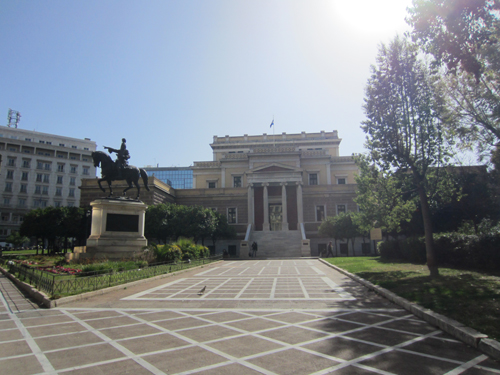
The National Historical Museum, founded in 1882, is the oldest of its kind in Greece. It is located in the Old Parliament House at Stadiou Street in Athens, which housed the Hellenic Parliament between 1875 and 1932.
The museum houses the collection of the Historical and Ethnological Society of Greece, founded in 1882. It is the oldest collection of its kind in Greece.

The collection contains historical items concerning the period from the capture of Constantinopolis by the Ottomans in 1453 to the Second World War, emphasizing especially the period of the Greek Revolution and the subsequent establishment of the modern Greek state. Among the items displayed are weapons, personal belongings and memorabilia from historical personalities, historical paintings by Greek and foreign artists, manuscripts, as well as a large collection of traditional costumes from the various regions of Greece. The collection is displayed in the corridors and rooms of the building, while the great central hall of the National Assembly is used for conferences.
The Gazi
Industrial Gas Museum at Technopolis
technopolis-athens.com

Our apartment was located in the Gazi area near Kerameikos metro station. Here you’ll find a new cool place to be in Athens, full of restaurants, cafes, music, and art by the old city gas-works which has been turned into a museum-cultural center that may be unique in all of Europe.
New York Times Travel wrote about this recently and it is certainly now, eclipsing Psiri as the best place to be at night.
Gazi is a neighborhood of Athens, Greece. It surrounds the old Athens gasworks, which is an industrial museum and exhibition space, widely known as Gazi, next to Keramikos and close to the Acropolis. It is home to the Technopolis of Athens, that spreads in an area of about 30,000 m2, an industrial museum of modern architecture. Gay bars had been located in Kolonaki and at the beginning of Syngrou avenue. Gazi is now home to numerous gay and lesbian bars, clubs, cafeterias and restaurants. Kerameikos metro station on Line 3 of the Athens Metro is adjacent to the Technopolis of Gazi.
Technopolis City of Athens has become a hub of cultural events, thus upgrading a historic area of the capital and creating another focal point in the cultural identity of Athens.
A wide variety of cultural events are held in Technopolis every year: music, dance, theatre and performing arts, plastic and applied arts, educational programs for children, entrepreneurship and temporary exhibitions, attracting over 600,000 people annually. Technopolis City of Athens offers quality entertainment and culture in reasonable prices.
Cape Sounio
ancient-greece.org and
en.wikipedia.org/wiki/Sounion

We wanted to see something outside the city, and decided to take a day trip to Cape Sounio by bus. Sounio is located on the southernmost tip of Attica; it is the end point of the Athenian Riviera, at a 69 km distance from Athens. We took the intercity coach (KTEL) from Aigyptou Sq. (Victoria Metro Station). It took us 2 hours to get there and 2 hours back. You will be impressed by the lovely view of the sea and of the Saronic Gulf Islands.

At Sounio, you’ll find the temple of Poseidon, the ancient Greek god of the sea, dominates the southernmost tip of Attica, where the horizon meets the Aegean Sea. Perched on the craggy rocks of Cape Sounio, the temple is enveloped in myth and historic facts dated from antiquity until the present times.
Places to shop:
Attica Department Store
9 Panepistimiou streat near Syntagma Square in Athens
www.atticadps.gr
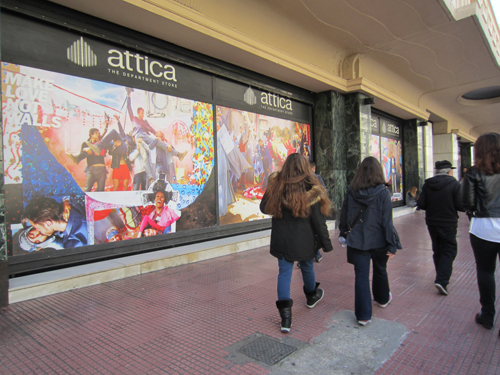
Attica is the largest and most fashionable department store in Greece, housed in a historically preserved, neo classical building. Since the beginning of its operation in 2005, attica has become synonymous to a unique shopping experience. Situated in the center of Athens, it showcases a wide array of high-end designer brands and excellent, personalized services. attica offers a complete sections of womenswear, menswear, childrenswear, sportswear, accessories, jewelry, traveler’s items and homeware.
The unique window displays, the immaculate interior architecture and a café-restaurant with a breathtaking view on the top floor make attica equivalent to some of Europe’s most famous department stores, such as Harvey Nichols, Harrods and Gallery Lafayette.
attica is located at City Link, which occupies a whole building block surrounded by Panepistimiou – Voukourestiou – Stadiou – Amerikis streets. It is very close to Syntagma Square, Kolonaki, Ermou street and Omonoia Square.
Funky Buddha Store
Ermou 23-25 in Athens
www.funky-buddha.com
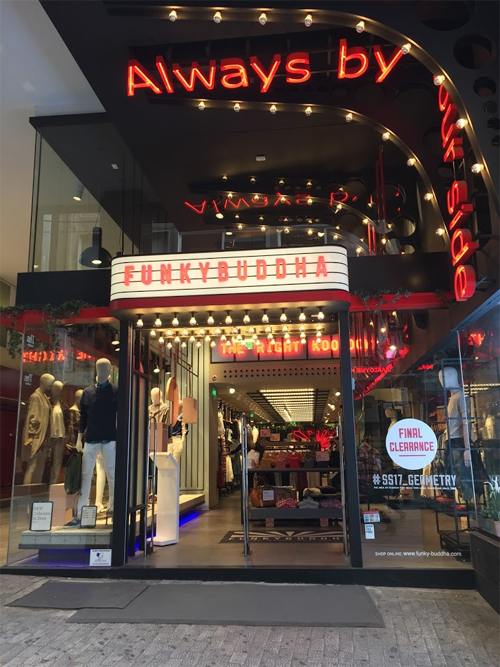
In the heart of the commercial centre of the city, on Ermou Pedestrian Street, Funky Buddha features its flagship store, where you will find the complete collection of the company, which consists of comfortable and affordable clothing of high quality that suit any person, expressing their personality. The collections are bold, with influences from music, art, travel, love for the environment, strong emotions and modern ways of expression. And it is Greek fashion!
Korres Natural Products
Ermou 4 in Athens
www.korres.com
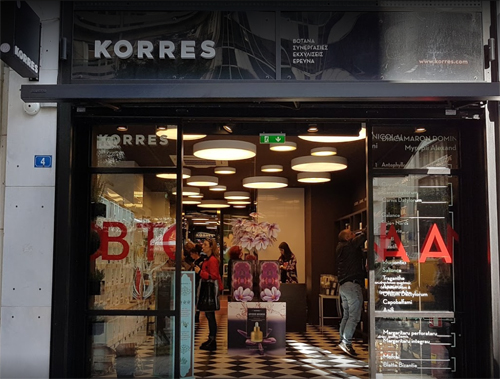
You can get the full range from this natural beauty-product guru at the company’s original homeopathic pharmacy – at a fraction of the price you’ll pay in Stockholm, Amsterdam or New York. There’s also a branch at the airport, and one near the Panathenaic Stadium.
Forget Me Not Store
Adrianou 100 at the Plaka in Athens
www.forgetmenotathens.gr
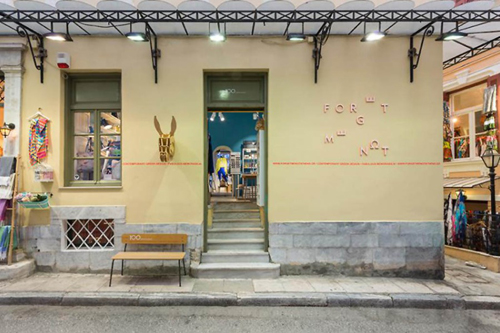
Nice store with contemporary greek design and some fabulous memorabilia from Greece and Athens. They have a fine range of products by young Greek designers, especially souvenirs possessing humour and Greekness. You will find it in the Plaka area.
Anamnesia Store
Athens International Airport
www.facebook.com/anamnesiagifts
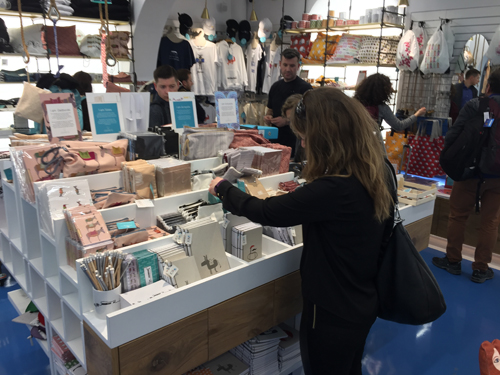
Anamnesia is a new Greek brand that promises to keep your journey’s memories alive! The store calls you to a unique journey through a wide range of souvenirs that combine high aesthetics and affordable prices.
Places to eat:
Oinomperdemata
Vasiliou Mega 10 & Stratonikis in Athens
www.oinomperdemata.gr
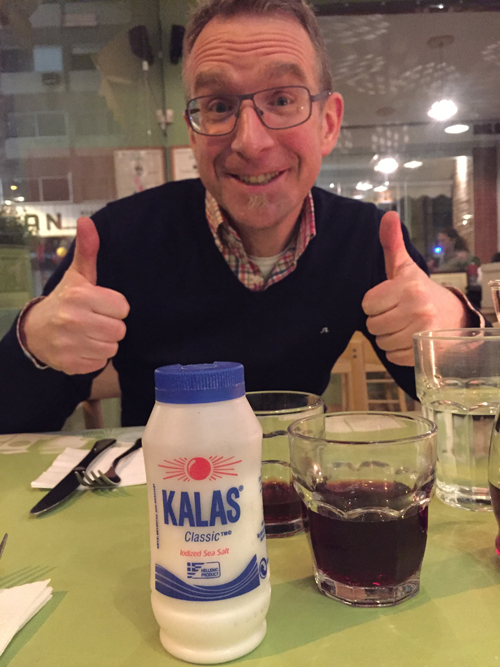
Oinomperdemata is a modern restaurant with homemade meals, that sweet smells favorite flavors. They cook different recipies daily that you can either enjoy in our restaurant or they can deliver your package to your place.
They are located near Technopolis – Gazi and Kerameikos metro station.
Psitopoleio O Nikitas
Agion Anargyron 19 in Athens
www.mesogeia.net
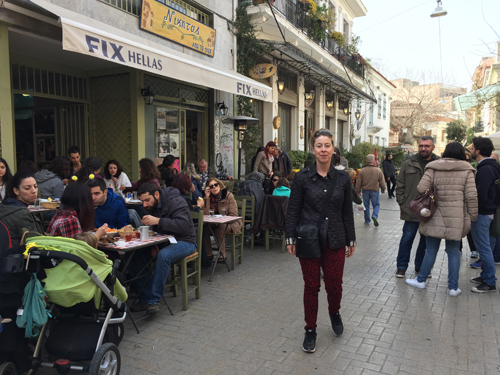
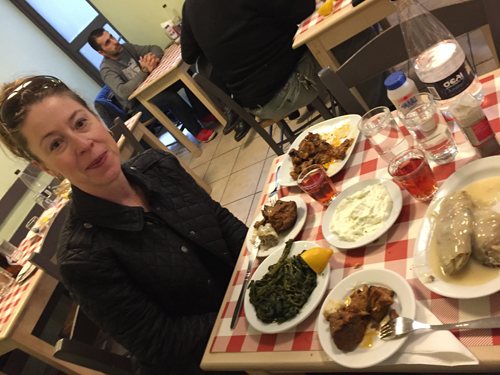
Locals swear by this tried-and-true taverna that has been serving reasonably priced, refreshingly simple and tasty traditional food since well before Psyrri became trendy. It’s the only place busy on weekdays.
Melilotos
Kalamiotou 19 in Monastiraki in Athens
www.melilotos.gr
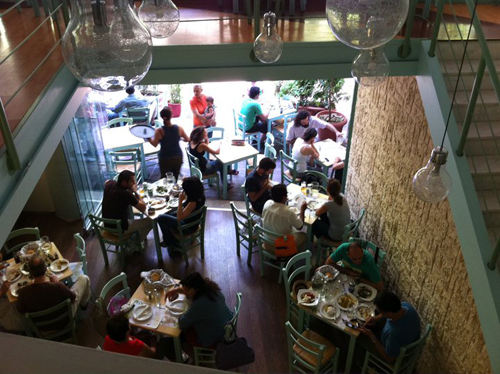
Retooling traditional, local dishes at decent prices, Melilotos is at the forefront of an Athenian restaurant wave not unlike Britain’s gastropub boom. In a neo-rustic pistachio-coloured dining room, this restaurant near Syntagma Square serves excellent grills and unusual specialities such as one-year-old Cretan gruyère and aubergine salad with walnuts. (www.theguardian.com)
Aleria Restaurant
Meg. Alexandrou 57 in Athens
www.aleria.gr


Aleria first opened in 2006. The owner, Nikiforos Kehayiadakis, decided to take the risk of locating it in the upcoming Metaxourgio area of Athens. Focusing on the combination of exquisite cuisine and wonderful design, he succeeded in creating one of the best and most beautiful restaurants in Athens.
The designer Sofia Kehayiadaki, managed to strike the perfect balance between luxury and ambience, creating a restaurant which is quite formal but still unpretentious, cozy and full of elegance. Everywhere around there are decorative elements that draw your attention due to uniqueness and ingenuity. It may be the very original light fitting over the bar, which has been made of empty wine bottles hanging upside down, or the ground floor surface which in certain segments is made of clear glass, allowing glimpses into the once basement cellars, now transformed into indoor gardens.
Beyond the exquisite design, it is worth visiting Aleria to taste the food it offers. While adopting from the start a ” Nouvelle Cuisine Grecque” philosophy, the dishes are always equally creative and imaginative, as they are delicious. Chef Gkikas Xenakis who is in charge in the kitchen since September, has already presented excellent examples of his talent and abilities with creations such as wild mushrooms ragout with trahana and parsley sauce, slowly cooked pork belly with celery root puree, coriander sauce and pickled onion and foam rice with bitter chocolate with white rice mousse, cinnamon and lemon sorbet. (Delood – Daily Design Magazine)
Sardelles & Butcher Shop
Persefonis 19 in Athens
www.hellenicfood.gr/sardelles & www.hellenicfood.gr/butchershop

Sardelles and the Butcher Shop at 19 Persephoni street are modern versions of a ‘traditional’ psistaria specializing in fish dishes or grilled meats. If you are a vegetarian don’t fret. They have lots of salads and eggs too! But you can’t beat their paidakia (lamb chops) and their choice of sausages and cheeses from all over Greece. Try the loukaniko agrioxoirou which is wild boar sausage. The eggs, chicken and even the wild boar are organic or all-natural. All the meats are from Greece. If you are not into meat then right next door is Sardelles, which seems to be the same owner and is as good as the Butcher Shop though it has only fish. Delicious whole fried shrimp, grilled thrapsala (cuttlefish), white tarama salata, and of course grilled sardines. These two Gazi restaurants are as good or better than anything you will find in Psiri or the Plaka. Both The Butcher Shop and Sardelles were opened by super Chef Panayotis Papanikolau and in the last couple years Sardelles and The Butcher Shop have combined into one restaurant.
MyPlate
Persefonis 43 in Athens
myplate.gr
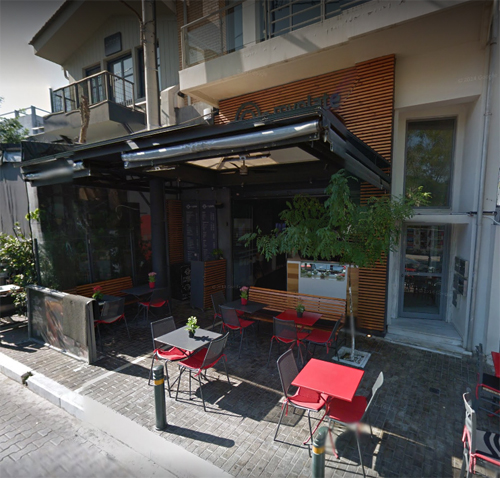
Great place if you want some quick but great Greek food, even take out or home delivery. Close to our apartment, so we took it home on our way home, after a long day in the city.
The chef Panagiotis Konstantinidis, using only fresh ingredients highlights and enriches traditional dishes. The location of the shop is close to the metro on Central Square Kerameikosand open 24 hours.
Places to drink:
KUKO’s the bar
Kalamiotou 4, Athina
instagram.com/kukosthebar and facebook.com/kukosbar


In a renovated neoclassical building from 1890, on Kalamiotou 4 in central Athens a very nice bar, Kuko’s is located. Harmoniously combining the classical with the industrial style interiors that have been kept intact, with minor color interventions. Worth mentioning, however, is the food menu, as it consists of cold suggestions like salads, baguettes and bruschetta with club sandwich and pizza are already at the top of public preferences. All dishes are prepared at the time of ordering homemade. The music moves in jazz, funky, soul, rock and (a little) house rhythms with theme nights and guest djs to take place during the week.
Faust
Kalamiotou 11, Athina
faust.gr


It’s an atmospheric bar downtown with elegant and sophisticated decoration. It also operates as a theater and the stage has hosted many performances like the dark and eccentric “Opera chaotique”. The bar also serves supreme quality food and well crafted cocktails. This grotesque bar is something that stands out in this neighborhood and is gaining more and more popularity among the lovers of alternative art. The food is great value for money and represents faithfully the quirkiness of the place. The jazz music and the atmospheric vibes, make it ideal for couples.
Nancy’s Sweet Home
Iroon Square 3 in Athens
nancysweethome.gr


Nancy’s Sweet Home also know as Serbetospito is the sweetest spot in Athens, located in the neighborhood of Psyri near Monastiraki. If you want to taste great greek traditional desserts with a twist or you are a chocolate lover, this is the place to be. Specilities include ‘kKiounefe’ with traditional kaimaki ice-cream on top and the ‘love dessert’ which is a chocolate cake with praline and chocolate sauce.
Couleur Locale
Normanou 3 in Athens
www.couleurlocaleathens.com


Couleur Locale opened its doors in the summer of 2014 to give a new and timeless local colour in the historic centre of Athens. Couleur Locale is nestled in a quaint arcade in Normanou street, in Monastiraki, and has two levels. Located inside the arcade, the ground level promises relaxing and carefree moments during the day, offering seriously tasty coffee prepared by specialized baristas, alternative snacks, appetizing cool salads, delicious club sandwiches, tortillas, mini burgers and so much more all made in the open kitchen of Couleur Locale. Using the elevator towards the 3rd floor, a small oasis is discovered! Its beauty is particularly impressive as once opening the lift door, the imposing hill of the Acropolis welcomes you! It shall not take long to realise that the splendid view is combined with a place especially designed with real care and deep knowledge concerning what a true bar should be like. The roof bar of Couleur Locale operates throughout the whole day. At nights and on Sundays, starting in the afternoon, the renowned cocktails are accompanied with jazz, soul, funky and rock’n’roll music played by alternate sophisticated DJ’s. All the above, in an absolutely welcoming and familiar environment with polite and quick waiting staff as well as reasonable prices.
Places to stay:
Athina Art Apartments
Orfeos 47, Athens
athinaartapartments.gr

During our week in Athens, we stayed here in the Blue apartment, booked directly with the owners.
Offering a seasonal outdoor pool, Athina Art Apartments are centrally located in Athens. The elegantly designed apartments come with an indoor hot tub. Free WiFi and free private parking are offered.


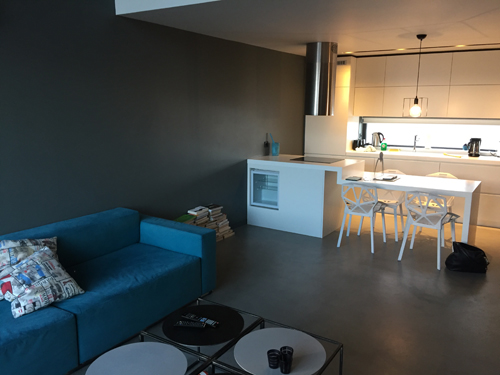
Athina Apartments boast a modern seating area with a satellite, flat-screen TV and Blu-ray player. Each opens to a furnished balcony with views of Athens. The fully equipped kitchen is fitted with an oven and microwave. The world-renowned Acropolis and its museum is at approximately 4.5 km. The lively area of Monastiraki, boasting an array of traditional taverns and shops, is located within just 2 km of the property. There are several public transportation stops nearby, connecting the property to several areas of the city. Athens International Airport is at 40 km. You may reach the apartment either by metro Kerameikos station (3 minutes walk) or 200 m. and the Blue line which runs all the way to the airport (when there isn’t a strike). The metro had a 24 hour strike on our arrival and departure day. Taxi and Uber works also fine in Athens!
Some other helpful guides:
www.theguardian.com
Athens Guide on Gazi
www.thisisathens.org
www.greece-athens.com



 Posts
Posts